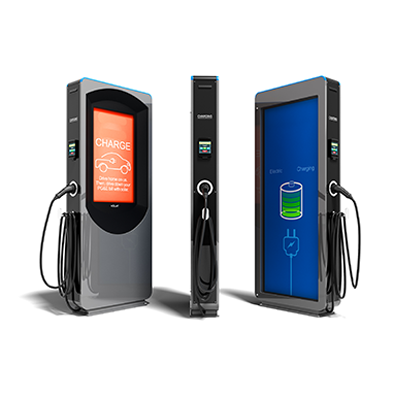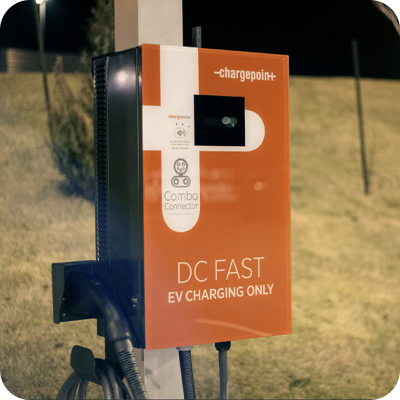Seven Tips to Craft a Great Experience for EV Owners
1. Provide a soft learning curve for new users
There are two important considerations here:
First, ease-of-use software with a clean UI/UX is vital since some users may not have strong electronic-skills. Big touch screen buttons eliminate mistakes—look at the massive video-order-terminals in your typical McDonalds—but don’t stop there.
You’ll want voice assist to aid people while their hands are busy with the task. Don’t sell yourself short, however, by not understanding the future. Self-driving cars are on the horizon, meaning the vision or hearing impaired will need to use your vehicle and your charge points.
Second, improve the EV user experience by making electric vehicle maintenance easy for people charging at home. Even if they don’t have a 220-volt outlet, EVs can still use 110-volts, so make that part of your considerations with the slower charging speed.
2. Quick & accurate reporting of vehicle’s charge state
People need the security of knowing how far they can expect to travel without interruption. Even though the majority of electric car owners never approach the limit of their range, it still factors in at 20% of overall satisfaction with their EV user experience when the estimates accurately reflect the practical range. Do what you can to simplify electric vehicle maintenance. This means only charging when necessary and not every time you park the car.
Winter driving can lop off just a single percentage point or range for Teslas (though owners know that varies quite a bit), all the way up to BMW i3 at 24%, the Chevy Volt & Bolt at over 30%, the Ford Mustang Mach E at 28%, VW e-Golf at 23%, and with several others being in the mid-teens or less. If you’re using environmental controls (heating or cooling), that can lop off up to 40% in very hot or cold climates.
Estimating software should “learn” the driver’s habits over time to enhance the accuracy of the reports, or have multifaceted reports (400 miles with a/c; 625 miles without) available to reflect the conditions. Smart Apps for phones must be easy to use. A glance should tell users if charging is necessary for a planned trip.
Car and software designers also need to consider time-of-use electrical rates; if the owner needs the car at 7 a.m., it can charge at user-selectable times, say from 9 p.m. to 6 a.m., if that is the most economical power-rate available.
3. Ability to check charging station locations easily
All electric car owners will soon have access to the Tesla Supercharger Network. Hurray! Many other CP operators already have software that allows you to survey your area for one of their CPs that is available, some of which are actually free to use if you happen to subscribe to their App to find them.
Include vital information—your customers are counting on you! If CPs are a specific type, suitable only for a particular design, make sure that is noted, too. This is particularly important for creators of non-proprietary apps which cover multiple networks—identify the available types of chargers and connections.

Level One chargers are starting to become available on parking meters in some cities as a free benefit for parking space users. It’s slow at just 4-6 miles of range per hour of plug-in time, but it may be enough to get you where you need to go in a tough situation. Level Two chargers can give you 25 miles per hour of plug-in time. Rapid DC-chargers can give you 100-200 miles of range in just 30 minutes.
4. Ensuring charging cable/plug-in compatibility
Hopefully every CP will adopt OCPP (Open Charge Point Protocol), or the ISO 15118 standard. This will mean an improved EV user experience such that any EV will be able to use any CP that uses the standard.
More important, however, is the notion of seamless Plug-n-Charge, where the car self-identifies, in an ultra-secure fashion, so that all you have to do is plug in and walk away. It will handle all the billing and accounting with no further interaction on your part. You don’t need a card, a charging key, a QR-code, a PIN, an app, or a physical credit card. Some are even going so far as to have a detachable device that will tell you the current charging status or when the charge is complete. You take it with you and return it to get your car back.
5. Give drivers the option to pre-book charge locations
The majority of charging is done at home (about 80%). People know what to expect with their own system and tendencies. Folks travelling greater distances face a different problem.
If it’s 400 miles to Grandma’s house, you’re not going to be able to perform a round trip on one charge no matter what you’re driving. App developers need to show the locations (and particularly the types) of chargers that are available. Twelve hours on Grandma’s 110v service may only provide 50 miles of range, but a half-hour stopover at a mall or restaurant with a Rapid Charge would solve the entire issue.
If you can consolidate your charging-station maps with reservation options you will simplify life for people. The idea of putting a hold on an available CP for 15 minutes (until clients have time to arrive) will avoid delays in their travels, increase their satisfaction with your service, and amplify satisfaction of all users. More people will feel comfortable buying an EV because the infrastructure is solid.
6. Offering a flexible payment approach
If the industry adopts Plug & Charge, aka the ISO 15118 standard you won’t need a card, a charging key, a QR code, a PIN, an app, or physical credit card. People using different systems sometimes cannot charge because of non-standardization and inconsistency.
One situation that frequently occurs is when your payment method expires (say you received a new credit card in the mail but didn’t update it on your charge plan, for instance). What do you do? CP operators have to deal with a barrage of phone calls every day where people can’t charge, can’t unplug their cars or can’t pay. Particularly from Tesla drivers using an outside system they are not familiar with because the Tesla Supercharger Network works so well.
Until this new protocol is more ubiquitous, and if you’re often charging in an area that is “spotty” for cellular reception, it might be smart to keep a charging-key in the car. That way you don’t have to be able to get a connection to charge the car.
The ISO 15118 standard even applies to wireless charging available on many cars nowadays. Just like dropping your phone on a Qi pad, or hanging your smartwatch on its stand, a wireless car charger works when you park above it. It connects wirelessly to the system, arranges payment and charges the vehicle. Some people are getting 3.3kW & 7.2kW systems installed in their garages. You drive in, get out of your vehicle, and it automatically charges.
The protocol makes electric vehicle maintenance a snap. It allows owners to charge their vehicle just by plugging it in. All communication takes place via the charging port — they connect the plug to the car, the car communicates with the e-mobility service provider to identify the account and payment method, and the CP initiates charging, after which the total is billed.

7. Provide stellar customer support
The electric vehicle experience will get easier and more efficient with time. Early adopters are real experts now, flying seamlessly through the system. Newer buyers of EVs are struggling with their electric vehicle experience. Just when they think they have it all figured out, they have to charge at a new location and all the protocols are different and confusing.
It’s essential to ensure that customer support is available to answer customer queries and assist in resolving problems when necessary. Dealing with an expired payment method, a misplaced charging key, or an unreadable QR-Code all have to be “easy fixes” for the customer. To ease the experience, many CP operators will charge the car for free while on the phone with the customer as they sort out the difficulty. The cost is trivial and makes for a great user experience.
Some of the people with the most disposable income are aged 60+, and are inspired to leave a cleaner, healthier planet for their descendants. They were the very first computer users, and are surprisingly adept at using technology, but they can run into problems when they come up against a new system of charging that they’re not familiar with. Good customer service reps on your phones will make their electric vehicle experience memorable, and these 60+ folks have a lot of influence over a wide demographic, so let’s make their experience great!
Good electric vehicle experience as key to increasing adoption
EV adoption is a team sport for not just car manufacturers, but for charge point operators and e-MSPs. It’s not a one-person show, or something that can be advanced by a single entity.
To remove the remaining barriers to EV adoption, car owners need a flawless experience from beginning to end. Driving their new “pride and joy” off the lot only begins the journey.
Can they charge at home flawlessly (wirelessly or plugged-in)? Can they find and easily use CPs wherever their travels take them? Are financial transactions secure, faultless, and easy?
The successful adoption of EVs is up to everyone, working together to build success. OEMs need to cooperate and avoid proprietary/incompatible technologies; CP operators need to provide an assortment of charging options so no one gets left out. The e-mobility providers and payment services need to accommodate a wide variety of payment methods so you don’t strand customers with the oddities of your payment system.
If you’re looking for a partner who’ll support you in creating the very best experience for your EV customer base, then get in touch!






